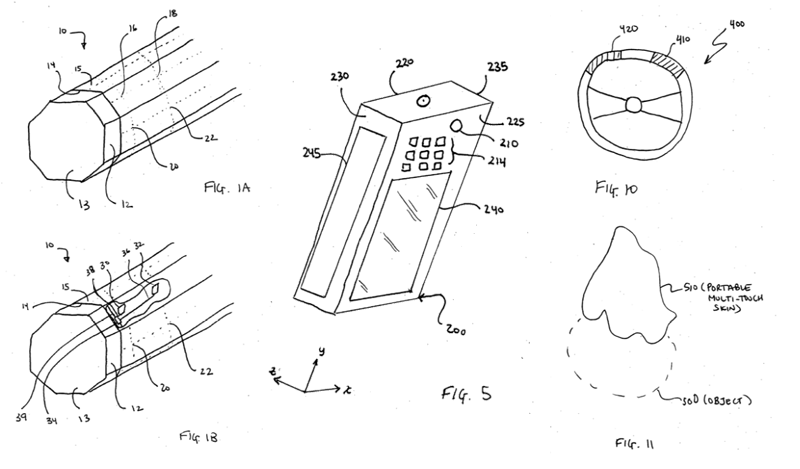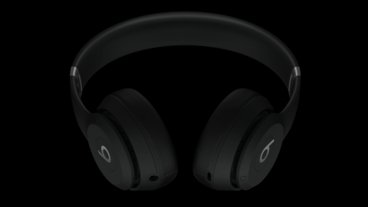Apple exploring portable multi-touch skins for 3D surfaces
The Cupertino-based company notes that in the case of both touch pads like notebook trackpads and touch screens like those on the iPhone, the user moves one or more fingers on a two-dimensional surface to operate the device.
"However, for the operation of many devices, it is desirable, preferable or even necessary for the user to move his or her fingers over a three-dimensional surface," the filing states. "This is directed to a multi-touch skin placed along three dimensions of an object. A single multi-touch skin can be configured to span all three dimensions or two or more multi-touch skins can be used to span the three dimensions."
Apple says that one or more multi-touch skins can be permanently attached to an object or temporarily placed on the object for removal and application on a different object later on. When placed on an object, the skins would enable multi-touch inputs for that object that can be tracked to monitor the operation of the object.
Multi-touch skins could also include gestures for configuring and operating the objects, according to the filing, which would include implementing "any number of GUI interface objects and actions."
"This also relates to an improved multi-touch skin for measuring the magnitude (Z) of a touch," Apple explained. "In one example, the multi-touch skin has a corrugated surface. "This also relates to a multi-touch skin that can measure not only the magnitude (Z) of a touch, but also the force of the touch in one or more directions, i.e., the x, y and/or z directions. The four types of data can enable a broad vocabulary of actions and gestures."
Of the many potential real-world applications, multi-touch skins can be used to operate a steering wheel on a motor vehicle or for instructional purposes in the sporting world, such as teaching people the proper way to grasp a tennis racket.
"For example, the tapping of an index finger on multi-touch skin can be used to perform channel selection of a radio in the vehicle. Each tap can correspond to a selection of the next available channel. The tapping of an index finger and pinky finger on multi-touch skin can be used to perform volume selection of the radio," Apple said. "Each tap of an index finger can, for example, correspond to a step increase in volume, while a tap of a pinky finger can correspond to a step decrease in volume. In this way, the user can simultaneously change channels with one hand and control volume with the other hand, without have to focus his attention on the vehicle's radio. Of course, these two gestures can be also be performed separate in time.
Two multi-touch skins could also be used together to configure the operation of the vehicle and another skin, the filing goes on to say. For example, the tapping of two fingers on one multi-touch skin can be used to change the mode for another multi-touch skin from volume selection for the radio to wiper speed selection. The tapping of an index finger on multi-touch skin would then correspond to a step increase in wiper speed while the tapping of a pinky finer would then correspond to a step decrease in wiper speed.
"In the case of a tennis racket or a golf club, for example, the coordinates of the player's grasp of the handle can be detected. The coordinates can then be analyzed to determine if the player has correctly grasped the handle for a forehand stroke or a drive," the filing adds. "The analysis may include obtaining other information, such as the orientation of the racket face or club head in relation to the grasp, to determine whether the player has correctly positioned his hand or hands on the handle."
Based on this analysis, actions can be performed to notify the player that he or she has correctly grasped the tennis racket or golf club for the stroke to be performed. A display on the skin, for example, can display a green light for a proper grasp and a red light for an incorrect grasp. If the grasp is incorrectly positioned on the handle, the display can further direct the player to correct the grasp. For example, the display can direct the player to move his or her index finger or thumb in a given direction.
The 23-page filing made June of 2007 is credited to Apple employee Steve Hotelling and Fingerworks founder turned Apple touch-gesture expert Wayne Westerman.
 Slash Lane
Slash Lane











 Malcolm Owen
Malcolm Owen

 William Gallagher
William Gallagher
 Mike Wuerthele
Mike Wuerthele
 Christine McKee
Christine McKee

 Andrew Orr
Andrew Orr
 Sponsored Content
Sponsored Content





